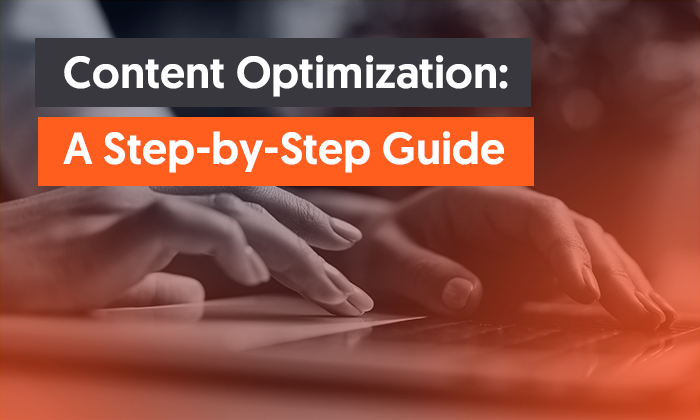
Is your content not getting the results it deserves?
Unfortunately, in today’s ultra-competitive, crowded SERPs, creating great content isn’t enough. You need to optimize it effectively if you want it to rank and sell.
That doesn’t just mean optimizing content for Google. You also need to optimize your content for readability and for conversions.
Confused? This is the guide for you. I’ll show you a step-by-step guide for optimizing your content. We’ll cover:
- what content optimization is
- why you need content optimization
- how to optimize your content for SEO
- how to optimize your content for readability and style
- how to optimize your content for conversions
- common optimization mistakes
Ready? Let’s begin.
What Is Content Optimization?
Content optimization is the practice of updating and improving your content so it has the best possible chance of achieving its goals. That goal could be ranking in Google, but it could also be converting readers into customers or acquiring backlinks. In many cases, it’s a combination of several of these metrics.
Why Do You Need Content Optimization?
From an SEO standpoint, content optimization is essential if you want to rank. You might have written the best article in the world from a reader’s perspective. But if you don’t optimize content for Google, it won’t rank.
Getting your content to rank in Google has many additional benefits. These include:
- earning backlinks
- growing your audience
- increasing leads
- building trust
Optimizing your content for readability improves audience engagement and helps your brand to build trust with readers. It can also help to position your brand as an authority. It’s a lot easier to trust a brand that clearly puts time into content creation compared to one that puts out barely legible content.
Optimizing content for conversions is critical if you want to squeeze as much money out of your efforts as possible. You’ll never write the best-converting piece of copy the first time around, which is why tweaking your headings, targeting new keywords, and improving your CTA is vital. In addition, goals for conversion may change over time, and you want to make sure your content adapts with them.
How To Optimize Content For SEO
Improving your content’s rankings is the primary reason for content optimization. So let’s start by looking at how to optimize content for SEO.
Keyword Research
Optimizing content for SEO starts with keyword research. You need to make sure you’re targeting a keyword that
- has traffic potential
- you can rank for
Ubersuggest is one of the best ways to find suitable keywords. Use the Keyword Ideas tool to enter a seed keyword and get a list of relevant keywords along with their potential volume and SEO difficulty.
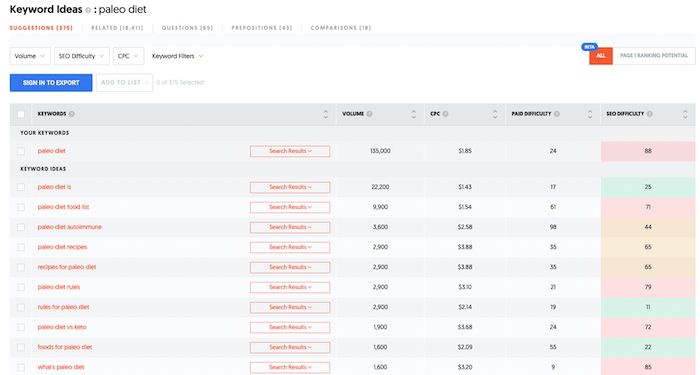
You’ll want to choose the keyword that best represents your content, but also has a decent amount of traffic and a realistic keyword difficulty. If your site is new, there’s little point optimizing for a term with an SEO difficulty in excess of 50. You’re fighting an uphill battle from the start.
You can also use this tool to find semantically related keywords that you should also use in your content. The more of these topics you include, the easier it will be for search engines to understand what your content is about.
Competitor Research
Once you have your keywords, it’s time to see what’s currently ranking on Google. In particular, you need to make sure your content aligns with what users are searching for. Luckily, that’s pretty easy to understand by analyzing each of the top-ranking results. Open them up and look at:
- The page type: is it a blog post, an e-commerce page, or something else?
- The format: is it a listicle, a how-to guide, or a review?
- The content: Do the top pages write about the same thing? Do they all come at the topic in a similar way?
Don’t try to be unique here. If Google is prioritizing blog posts over e-commerce pages for a certain query, then you need to create a blog post. The same goes for the content’s format and angle. Understand what Google wants and then deliver it.
Don’t just create cookie-cutter content, however. By analyzing the content for each page, you can see what’s missing and find places to add your own perspective.
Integrate Keywords Into Your Content:
At the same time, you’re editing your content to align with Google’s preferred format, make sure you’re integrating your keywords into your content.
You should include keywords in the page’s:
- title
- meta description
- H1 tag
- image alt tags
You should also naturally include your main and related keywords throughout your copy. Be careful of keyword stuffing, however. Keyword stuffing is when you fill a webpage with a specific term. Not only does this provide a terrible user experience for your readers — who have to trip over the phrase every other sentence — but it will also get your site penalized by Google.
If in doubt, err on the side of caution and follow Google’s advice:
“Filling pages with keywords or numbers results in a negative user experience, and can harm your site’s ranking. Focus on creating useful, information-rich content that uses keywords appropriately and in context.”
Add Internal and External Links
Internal linking is criminally overlooked when it comes to content optimization. The more internal links you have on your site, the easier search bots can crawl it, and the more link authority will be passed between pages.
Internal linking also makes it easier for humans to navigate your site.
When optimizing a page, list all related pages on your site and find a way to link to them naturally in the copy. Then go to each of these pages and make sure there is a link back to the page you’re optimizing.
How To Optimize Content For Style and Readability
Next, let’s look at how to improve your content from a human perspective. There’s no point in having an article that ranks well if users aren’t going to spend time reading it. At the same time, the more readers engage with your content, the better your rankings will be.
Improve Your Content’s Structure
Does your content look like a stream of consciousness, or is it carefully structured and easy to scan? If it’s more the former than the latter, then you’re going to need to reassess your content’s structure.
Luckily, improving your content’s structure and increasing visual comprehension is easily done:
- Add a table of contents at the start of the post
- Use bullet points to break up paragraphs
- Use headings and subheadings
- Add a takeaway sentence at the end of section
Add Images and Other Media
Another way to improve your content’s structure is to add images and videos to your content. Make sure the images are relevant and add to the content — in other words, limit the use of stock photos.
When you add images, improve your SEO by adding keyword-rich,descriptive titles and alt tags to all of them. But again, be careful of keyword-stuffing.
Imagine I’m writing an article about choosing the right sized moving truck and I want to include the following image:

Here’s a bad example of a title and description for this image.
Title: truck.png
Alt text: moving truck
Neither are particularly descriptive, despite including the keyword.
Here’s another bad example:
Title: moving truck.png
Alt text: moving truck image to find the right sized moving truck
This is a classic example of keyword-stuffing. The alt text has too many keywords that it becomes unreadable.
Here’s what the title and alt text should look lke
Title: loading-moving-truck.png
Alt text: Loading a moving truck with black crates
Both the title and alt text accurately describe the image and include a relevant keyword once. Were someone to use a screen reader on this image, they’d be able to imagine what it looks like fairly easily.
Optimize for Readability
If your users are spending their valuable time reading your content, make sure it’s a great experience.
There are lots of ways to improve your writing:
- Use a spellchecker to eliminate errors.
- Eliminate fluff like cliches and words like “that.”
- Use short sentences and write as you speak.
- Vary sentence length, so your copy isn’t monotonous.
- Write in an engaging tone.
Tools like Hemingway, Grammarly, and Writer are fantastic additions to your arsenal when it comes to improving your content’s readability.
Grammarly and Writer are writing assistants that will improve your spelling, grammar, and clarity. Think of them as spellcheckers on steroids.
So not only will they highlight spelling mistakes and suggest places to add an Oxford comma, they’ll also offer style and tone suggestions.
In the example below, for instance, Grammarly suggests you replace “very helpful” with “constructive” because it’s a stronger and more concise alternative.
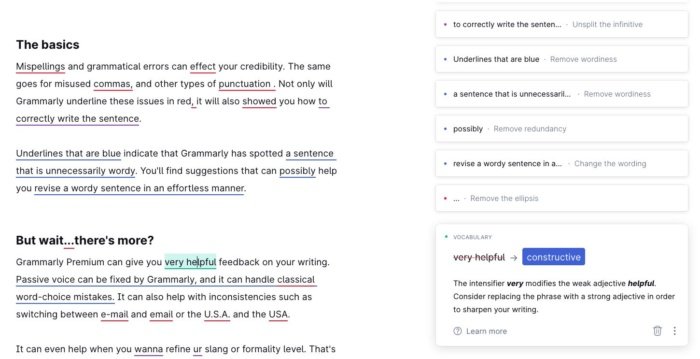
Both platforms have their own app and can be integrated into common writing tools. Writer, for instance, offers add-ons for Chrome, Microsoft Word and Figma. Grammarly can be integrated into an even wider range of tools, including Gmail, Outlook, Slack, LinkedIn, Notion, Google Docs and even Salesforce.
Hemingway can also improve your grammar, but it excels in suggesting ways to make your copy bolder, more concise, and more engaging.
For instance, it highlights hard-to-read sentences, suggests simpler phrases, and gives your content a readability score. It won’t turn you into Heminway, but it can certainly help you write with more style.
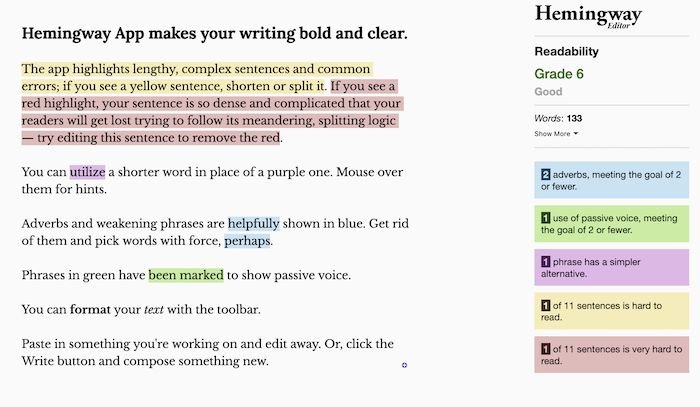
How To Optimize Content For Conversions
Good content converts. But here’s how to create great content that converts.
Target Commercial Keywords and Topics
Choosing the right topic is the first step to driving sales with content. Just as you did when optimizing for SEO, make sure the keyword you’re targeting has a high user intent. You can use Ubersuggest to analyze keywords, but the following sources are also a great way to find suitable topics:
- Quora
- Alexa
- Buzzsumo
Bonus points if your product or service is relevant to the keywords. For instance, we can use the related questions tab on Quora to find a great list of blog topics for a company that sells kitchen knives.

“Is a good chef knife worth it?” and “what is the best type of kitchen knife?” are great high-intent information-based topics that may be easier to rank for than a more general keyword like “best kitchen kife”.
Be Persuasive
There are several persuasive strategies you can use to make your copy much more enticing. These include:
- Add social proof to show real people love your product.
- Write in a friendly tone to get on your reader’s good side.
- Show your product works through case studies.
If you can combine several of these points in a single piece of content, even better. Take this blog post about e-commerce website security by BigCommerce as an example:

In a section about fraud protection, they include a quote from a store owner explaining how a specific app on the BigCommerce platform helped them reduce chargebacks after losing thousands of dollars in merchandise.
Not only does it show BigCommerce apps work, it also proves they are used by real retailers.
Improve your CTA
Every piece of high-converting content features at least one call-to-action. CTAs can take many forms. You could:
- promote a free trial
- encourage email sign ups
- add links to relevant products
CTAs typically come at the end of a landing page or blog post, but they doen’t have to. Buffer, for instance, include an email signup CTA in the middle of their blog post.
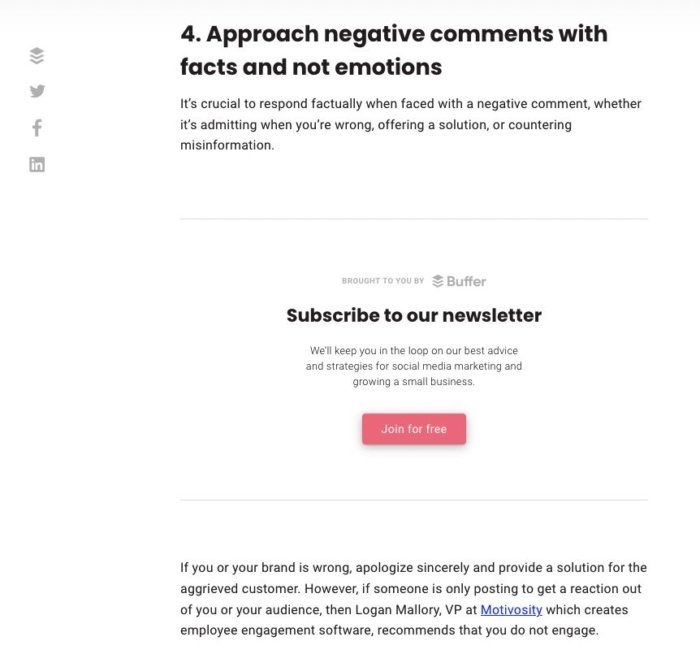
Note how hard it is to miss and how far down it is on the page. That’s on purpose. If you’ve read this far, there’s a good chance you enjoy the content and will want to be updated whenever a new post goes live. This CTA wouldn’t be half as effective if it was used at the start of the article.
What Are Common Content Optimization Mistakes?
Now that we’ve looked at the three major methods you can use to optimize your content, let’s cover the most common content optimization mistakes I see time and again.
- Not aligning content with search intent. Don’t just optimize your content for a specific keyword, optimize for the intent behind that keyword. If it’s an informational query, like “how to groom my puppy” make sure you write a how-to guide and don’t just sell your grooming tool.
- Failing to improve the reader experience. Many site owners spend ages improving their content’s SEO, but give no thought to the reader experience. The result is a lot of traffic but a huge bounce rate and no conversions.
- Not adding internal links. Internal links are an easy way to optimize a number of pages at once, yet they are criminally underused.
- Not improving the content. Content optimization isn’t just about adding keywords. You also need to make sure you cover a topic in its totality to rank well.
- Not deleting irrelevant content. At the same time, you should delete content that’s outdated.
- Over-optimizing content. It’s possible to go too far and stuff your content full of keywords. Avoid this at all costs. Not only will Google penalize your site, but it will also create a poor user experience.
FAQs
Content optimization is the process of improving your content so that it ranks better on Google and is more digestible to human readers.
There are several ways to optimize your content. You can improve your content’s SEO so that it ranks better in Google. You can improve its structure and readability so that it’s more engaging. And you can improve its sales elements like the CTA so that it converts more readers.
Content optimization offers a ton of benefits. It can bring better rankings, a larger audience, more backlinks and help you build trust.
Conclusion
Optimizing your content is essential if you want it to be read and drive conversions.. A well-optimized mediocre article will always perform better than a poorly optimized but well-written article.
So make sure you optimize your content for the right keywords, use tools like Grammarly and Hemingway to improve your copy and, and think about ways you can improve your copy’s conversion rate.
Do all three, and you’ll have a killer piece of content that ranks well, engages readers, and sells.
How are you going to optimize your content?




Recent Comments